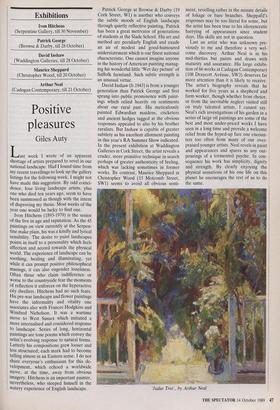Exhibitions
Ivon Hitchens (Serpentine Gallery, till 30 November) Patrick George (Browse & Darby, till 28 October) David Inshaw (Waddington Galleries, till 28 October) Maurice Sheppard (Christopher Wood, till 20 October) Arthur Neal (Cadogan Contemporary, till 21 October
Positive pleasures
Giles Auty
Last week I wrote of an apparent shortage of artists prepared to revel in our national landscape. Had I found time from my recent travellings to look up the gallery listings for the following week, I might not have made this suggestion. By odd coinci- dence, four living landscape artists, plus one who died ten years ago, seem to have been summoned as though with the intent of disproving my thesis. Most weeks of the year one would be lucky to find one.
Ivon Hitchens (1893-1979) is the senior of the five in age and reputation. As the 45 paintings on view currently at the Serpen- tine make plain, his was a kindly and lyrical sensibility. The desire to paint landscapes points in itself to a personality which feels affection and accord towards the physical world. The experience of landscape can be soothing, healing and illuminating, yet while it can prompt positive philosophical musings, it can also engender loneliness. Often those who claim indifference or worse to the countryside fear the moments of reflection it enforces on the hyperactive city dwellers. Hitchens had no such fears. His pre-war landscape and flower paintings have the informality and vitality one associates also with Frances Hodgkins and Winifred Nicholson. It was a wartime move to West Sussex which initiated a more internalised and considered response to landscape. Series of long, horizontal paintings are tone poems which convey the artist's evolving response to natural forms. Latterly his compositions grew looser and less structured; each mark had to become telling almost in an Eastern sense. I do not share everyone's enthusiasm for this de- velopment, which echoed a worldwide move, at the time, away from obvious imagery. Hitchens is an important painter, nevertheless, who steeped himself in the watery experience of English landscape. Patrick George at Browse & Darby (19 Cork Street, W1) is another who conveys the subtle moods of English landscape through quietly reflective painting. Patrick has been a great motivator of generations of students at the Slade School. His art and method are peculiarly English and exude an air of modest and good-humoured understatement which is our finest national characteristic. One cannot imagine anyone in the history of American painting manag- ing his wonderful little 'Wet day picture' of Suffolk farmland. Such subtle strength is an unusual virtue.
David Inshaw (b.1943) is from a younger generation than Patrick George and first sprang into public prominence with paint- ings which relied heavily on sentiments about our rural past. His meticulously painted Edwardian maidens, cricketers and ancient hedges tugged at the obvious responses appealed to also by his brother ruralists. But Inshaw is capable of greater subtlety as his excellent allotment painting in this year's RA Summer Show indicated. In the present exhibition at Waddington Galleries in Cork Street, the artist reveals a cruder, more primitive technique in search perhaps of greater authenticity of feeling, which was lacking sometimes in former works. By contrast, Maurice Sheppard at Christopher Wood (15 Motcomb Street, SW1) seems to avoid all obvious senti- ment, revelling.rather in the minute details of foliage or bare branches. Sheppad's responses may be too literal for some, but the artist has been true to his idiosyncratic harrying of appearances since student days. His skills are not in question.
Last an artist who was unknown pre- viously to me and therefore a very wel- come discovery. Arthur Neal is in his mid-thirties but paints and draws with maturity and assurance. His large exhibi- tion of 66 works at Cadogan Contemporary (108 Draycott Avenue, SW3) deserves far more attention than it is likely to receive. The artist's biography reveals that he worked for five years as a shepherd and farm worker, though whether from choice, or from the inevitable neglect visited still on truly talented artists, I cannot say. Neal's rich investigations of his garden in a series of large oil paintings are some of the best and most under-priced works I have seen in a long time and provide a welcome relief from the hyped-up fare one encoun- ters too often from many of our over- praised younger artists. Neal revels in paint and appearances and spares us any out- pourings of a tormented psyche. In con- sequence his work has simplicity, dignity and strength. By clearly enjoying the physical sensations of his one life on this planet he encourages the rest of us to do the same.
'Judas Tree', by Arthur Neal


























































 Previous page
Previous page